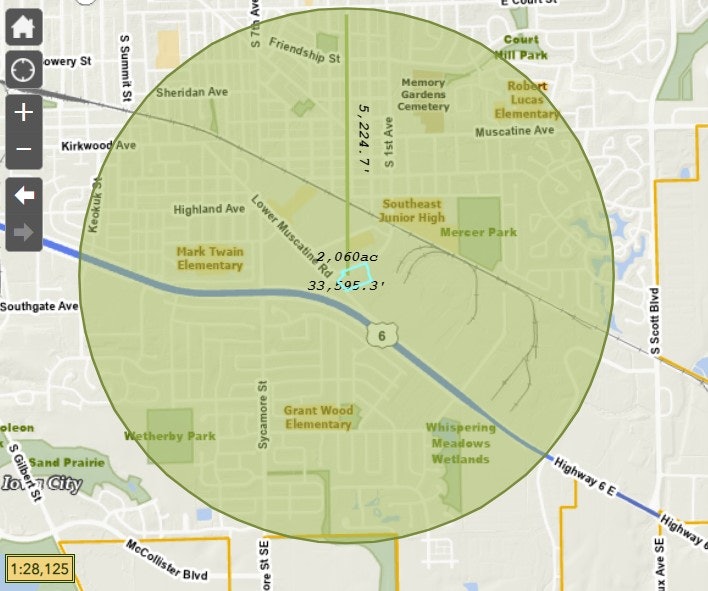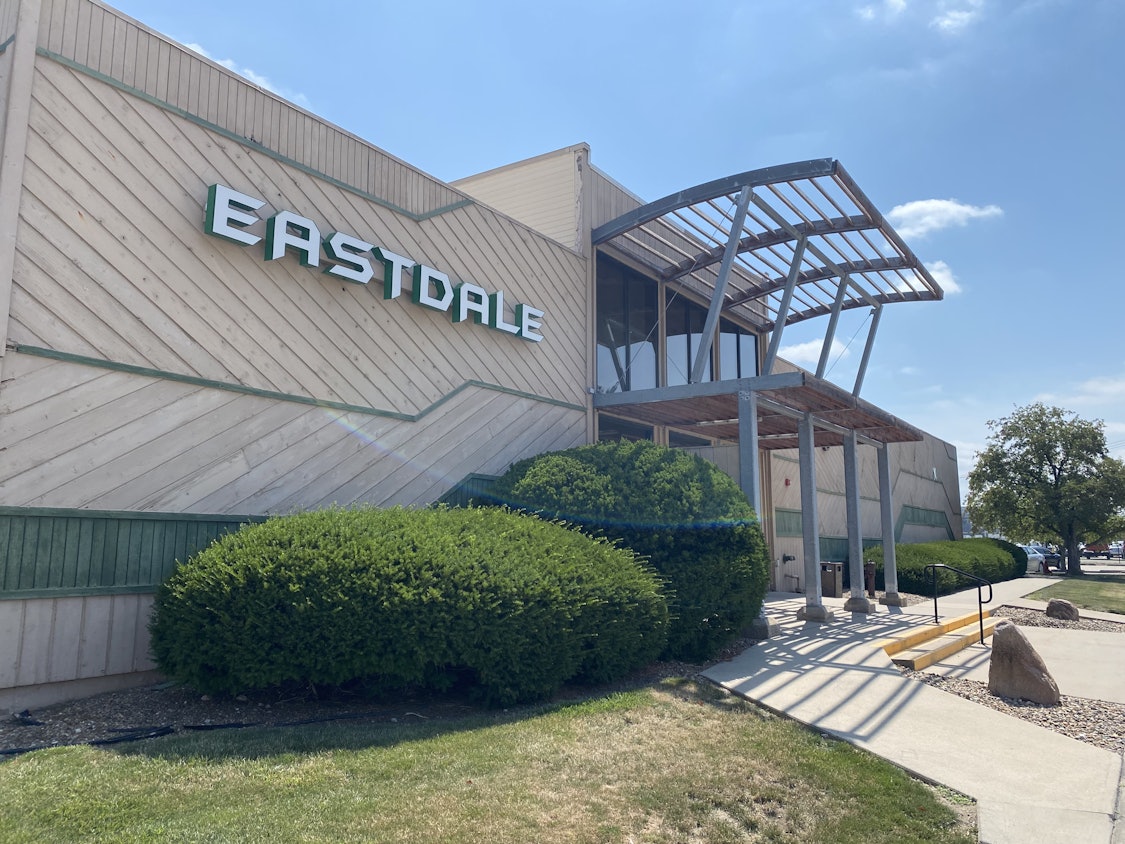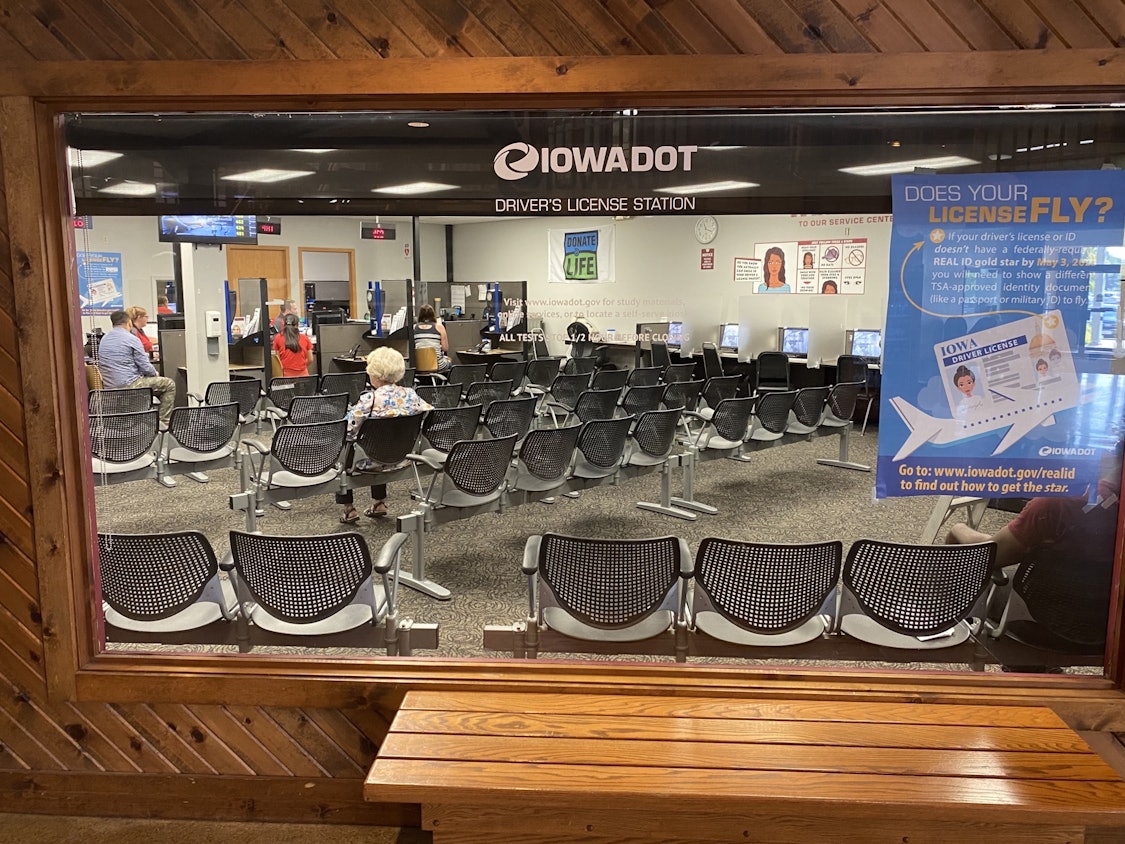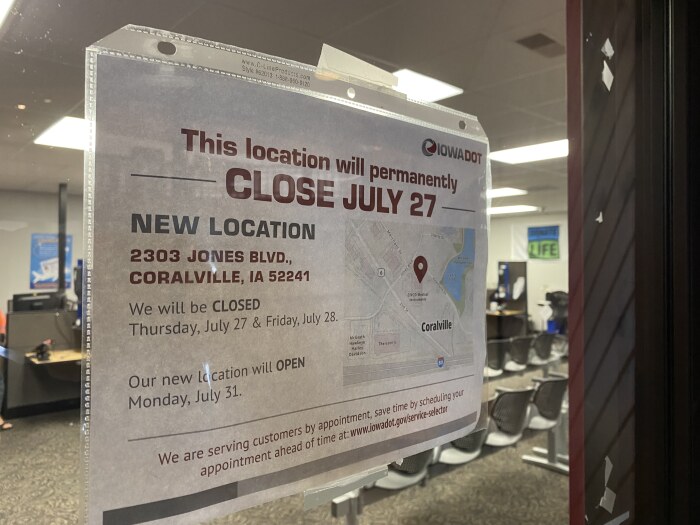Iowa City Council Member Shawn Harmsen represents Iowa City District B, which includes the east side of Iowa City and the recently closed DOT office.
In a move that will unevenly harm Black and other communities in the Iowa City area through lack of service and voting disenfranchisement, a major department of Governor Kim Reynolds’ administration executed a surprise move from an easily accessible location near several neighborhoods to a remote edge of another city.
The Iowa Department of Transportation sent out a press release on July 21 telling the public that after three more days in the Iowa City location it has inhabited for decades, that office would no longer be there. It was a classic Friday afternoon news dump before the start of RAGBRAI.
The press release claims the new location, out by Theisen’s and Costco on the very edge of Coralville, “was chosen after an extensive search for a space that could better accommodate the volume of customers in the area.” Unsurprisingly, these claims of “needing more space” and providing better customer service don’t stand up under any kind of scrutiny. In fact, as I will explain, the relocation looks less like an inept move than attempt to conduct racial and partisan voter suppression.
As you read my detailed analysis below, remember a few key facts for context.
In states like Wisconsin and Georgia it has been documented that after enacting unnecessary voter ID laws to stop nonexistent voter fraud, Republican trifectas soon followed up by closing and moving state DOT driver’s license stations—making it cumbersome for carefully chosen (by Republicans) groups of people to get any kind of official state ID.
It’s also important to note that the 2020 election in the Congressional district that covers Iowa’s southeast corner (including the strongly Democratic leaning Johnson County) was decided by just six votes.
ACCESSIBILITY
Like an onion, there are many layers to how bad a move this was. Let’s start with accessibility of location.
In Iowa City, the DOT location was located on a bus route of the largest public transportation agency in Johnson County, serving not only the largest city in Johnson County, but also the University of Iowa and its students.
In contrast, the location the DOT picked in Coralville isn’t on any existing bus route at all. In our community, we have three regular bus lines: Iowa City, Coralville, and Cambus. All connect in downtown Iowa City for folks transferring from one line to another.
In other words, the new DOT office location doesn’t even serve a whole swath of Coralville residents as well as the Iowa City location did, because they could have used the two bus systems to get there. Reynolds’ DOT moved their office with no replacement plan in place for those Coralville residents, either.
In addition to being an easily accessible (and starting August 1, free) bus ride in Iowa City, the location at Eastdale Plaza was in the middle of several neighborhoods, including some of the most racially and socioeconomically diverse neighborhoods in Johnson County. More on that to come.
The first map shows an area that is roughly within a mile of the Iowa City DOT location.

Just at a glance you can see multiple residential neighborhoods surrounding several schools. If we extended this circle out another half mile, it would include more of the neighborhoods around City High and near downtown. Sidewalks, and in some cases bike lanes, connect these residents to the Eastdale Plaza location.
Looking at a similar map of the new location, one can begin to see the stark difference. The new DOT office is near the store Thiesen’s, down the hill from Costco, two landmarks many area residents might recognize. Notice that there is very little housing of any kind within this mile radius. The vast majority is either commercial, interstate highway, or open land.

Overhead photos of the new location give another way to understand the inherent problems with this new location in terms of accessibility and providing an important service. And notice in the closer image, there is no sidewalk that connects to anything.


DISENFRANCHISING BLACK VOTERS
A bird’s eye view comparison of the two locations reveals some obvious problems with the Reynolds administration’s decision. Digging a little deeper, we see the disparate impact of making the DOT office less accessible. Remember, many people need a driver’s license or non-operator ID in order to exercise their right to vote.
According to the U.S. Census Bureau, Iowa’s statewide population is roughly 90 percent white (or about 84 percent non-Hispanic white), and only about 4.4 percent Black. If you look at that first map of the mile radius around the now closed Iowa City DOT office, you will notice several elementary schools and a junior high school. These serve as handy visual touchstones for several of the neighborhoods I’m talking about.
Again, according to census data, some of those Iowa City neighborhoods are made up of 20 to 44 percent Black residents. All of them are at least double or triple the statewide average for non-white racial diversity.
Our sister community of Coralville also has some wonderfully diverse neighborhoods. But not within walking distance of the new location. And no longer can residents catch a bus connection to get there.
This pattern is familiar to anyone watching what other Republican-controlled states have done to predominantly Black and other non-white neighborhoods to suppress those votes.
DISENFRANCHISING DEMOCRATIC VOTERS
Speaking of politicians picking their voters, the next layer of this spoiled onion to pull back considers the impossible coincidence that in or near that mile radius from the just vacated Iowa DOT office are some of the deepest blue precincts in Iowa City–which means some of the bluest in the state.
If you look at those same neighborhoods in the mile radius around Eastdale Plaza as voting precincts, the political motivation for such a move jumps into focus. Since we are coming up on another presidential election cycle, let’s look at the numbers from the last such contest in 2020. This is the one in which Republican Mariannette Miller-Meeks won the Congressional race by six votes.
In 2020, the five closest precincts to the DOT office (Iowa City 6, 10, 12, 14, and 15) gave between 72 percent and 85 percent of their votes to Joe Biden. If you move the view out a little wider to the next tier of precincts (Iowa City 1, 16, 17, 18, and 24) you find the vote in 2020 ranged from 72 percent to 90 percent for Biden.
It is not possible people in the Reynolds administration aren’t aware of how blue Iowa City is.
Again, if it walks like a duck and quacks like a duck…
DISENFRANCHISING STUDENT VOTERS
Imagine for a moment you are an 18-year-old woman coming to the University of Iowa. Like many of your classmates, you aren’t coming with a car as a freshman. You are living in a dorm, eating in the cafeteria, and a car can be an expensive hassle.
New to Iowa, you hear from your friends that the Republican state government wants to strip away your rights to control your own body and health care, and will be more than happy to force you to bear children. Now old enough to vote, you decide you want to vote for folks who will protect your rights and safety.
But on election day, even if you have changed your registration, your student ID is no good as voter ID under the law Republicans enacted. So, what the heck, you now live in Iowa City most of the year, why not kill two birds with one stone and get a new ID?
Last year, you could just hop a bus and get to the Iowa City DOT office. This year, if the DOT hadn’t pulled a fast exit, you could have hopped that bus for free. But instead, there is no bus to take you there.
Some students will be able to get a ride from someone. But for others, this will be just enough of an obstacle to keep them from getting it done. That’s exactly how Republican voter disenfranchisement works.
Keep in mind, they don’t have to stop everyone from jumping through their hoops, just enough to swing a close election. More than 30,000 students attend the University of Iowa. As we just saw three years ago, you may only need to keep, for example, a half dozen of them from voting for a Democrat to get a Republican elected, and mission accomplished. We also need to recognize that after the 2020 presidential election and the 2022 midterms, the desire among Republicans to suppress student votes has gotten so urgent some of them have started floating the idea of raising the legal voting age.
OTHERS WHO WILL GET SHAFTED BY THE DOT OFFICE RELOCATION
After this move was announced, I heard from a friend of mine in Iowa City whose husband suffered a seizure disorder about nine months ago, while he and his wife were awaiting their first child. This caused his driver’s license to be temporarily suspended for medical and safety reasons. Since then he has gotten the necessary care and they have figured out the medications he needs to be cleared to drive again.
Before last Thursday, he could just hop a bus and go get his license renewed. Now, he either has to wait for his wife’s schedule to line up with a DOT appointment, beg a ride, or risk driving to the new DOT office with a suspended license to get it un-suspended.
For someone like me, it’s easy to overlook the impact this relocation has on people. I’ve been lucky enough to have a car and have my health since turning 16; the only trick has been to avoid busy times and lines when I need to renew my license. And the latter has been much easier since the new online appointment booking the DOT has started using, which we used just recently as my own son turned 15 and we got his learner’s permit.
But as my friend’s story illustrates, there are lots of reasons a person may be unable to drive to the driver’s license station. Maybe it’s a medical reason. Maybe you don’t have your own car or have to share a vehicle with family members. Maybe you have a disability which prevents driving, or you have aged out of driving, but you still need a current state-issued ID to access any number of goods, services, or the ballot box.
FRIDAY NEWS DUMPS AND ATTEMPTED FAIT ACCOMPLI
Anyone who has been in the news business for any amount of time quickly becomes used to public officials sending out press releases about unpopular decisions on a Friday afternoon. Newsrooms are about to have smaller weekend staffs, and news audiences are going to be on their weekend routines. By Monday, in a busy news cycle the information might feel a little stale, and might be pushed aside by other “newer” news. Double lack-of-transparency points if this happens on a longer holiday weekend.
The press release announcing this move came out at 12:30 pm on Friday, July 21. While this was not a holiday weekend for most of the world, here in Iowa it was two days before RAGBRAI. A whole lot of people will spend the next week consumed with riding their bikes or providing some kind of service or news coverage of those same riders.
Compounding the problem, the press release on Friday announced that the coming Wednesday, July 26, would be the last day for the DOT office to be open in Iowa City’s Eastdale Plaza, and it would be closing for good on the 27th. That’s three business days of notice for customers and the community.
This move was brought to my attention on Monday by someone who saw the press release or maybe read the story about the press release in the Cedar Rapids Gazette, and so I joined those asking around and looking into the situation.
One thing I did was get over to the Iowa City location to take some photos on the last day the DOT office was open. News stories like photos and video, and if nobody captured those images, the only visuals for the stories will be in the new place.

Anyone who reads the press release will see something about needing a bigger facility to accommodate the public. Let me draw your attention to the photograph with several people being served, and just one person sitting in rows of empty chairs in the waiting area.


The press release also claimed the DOT had conducted an “extensive” search. I have been asking around for a week now, and have yet to talk to any elected officials or staff from Iowa City, Coralville, or Johnson County who knew anything about the relocation. Nor were any of them approached to help with this “extensive” search.
This kind of sudden move with no public input or warning is what is known as a fait accompli, which Oxford Languages defines as “a thing that has already happened or been decided before those affected hear about it, leaving them with no option but to accept it.”
I personally am not yet convinced we merely have to accept this, but I am convinced that this was the intent behind the way this was handled.
WHAT’S NEXT?
While I have no doubt the Reynolds administration would love this to be done and done, we shall see.
In the meantime, it’s my understanding that members of Iowa City’s state government delegation and some of my fellow council members are doing their own work looking into this.
I also am aware of requests that have gone to the city of Coralville to add a bus route to serve the new location, but I have not yet had any conversations with my city council counterparts in that community about this question. They are good people, and I know they will immediately grasp the problems of access I have outlined.
While I have no intention of speaking for them, I will say that from what I’ve seen from my time in and around the Iowa City council, changing bus routes isn’t the kind of thing I would expect to see in a couple days. Any change has a domino effect on other routes, timing, and staffing. Cities tweak routes on a semi-regular basis, but from what I’ve seen this requires some planning to do well. That’s one more example of how the state government’s decision to move the DOT office, as well as the way it was done, was a major disservice to everyone involved.
But make no mistake: even if Coralville is able to mitigate the harm from the DOT’s decision, adding a bus route is not a perfect solution. The new office will still not be walkable. It might once again be available by bus for some of the Iowa City neighborhoods I mentioned earlier. But instead of a short bus ride, it will require a transfer to get from an Iowa City bus to a Coralville bus, all while juggling personal schedules and the DOT scheduling system.
In short, if the DOT facility stays in the new location, the best-case scenario is that the people in the largest city in the county will have to spend more time, more hassle, and more money to get a driver’s license or non-operator ID so they can vote. That is the penalty for a track record of not voting for Reynolds and her party.
I expect this is just the beginning of this latest story of political payback and voter suppression by Iowa’s Republican-controlled state government.
This is no way for a state government to do business. I don’t care which party is in charge. No one should be okay with this.
All photos provided by the author and published with permission.


4 Comments
IDOT Commission
There is a 7 member IDOT commission. They have the ability to question this. Interesting to hear their opinions??
nkm Wed 2 Aug 7:49 AM
IDiOT Commission
The IDiOT Commission is dominated 4-3 by Republicans. How do you think they will rule on such a question? Until Iowans get smart and throw the GOP out on its ear, Iowa will continue to circle down the drain.
muskrat Wed 2 Aug 12:45 PM
Democracy Test Question...
You are a college-age student living in Iowa. Presumably you’ve heard about the constitution and the right to vote…and your responsibility to take part. When finding out that politicians have made it harder for you to vote, do you:
1. Give up and head to Hamburg Inn for a brewski?
2. Go to social media to say “this sucks?”
3. Refuse to let yourself (or your friends) be disenfranchised. Find the damn registration/polling places and “get it done.”
dbmarin Thu 3 Aug 8:30 AM
More to the story...
I have heard (but have no evidence) that the DOT will now be paying rent to folks who are big Reynolds contributors. This should be investigated.
Rod Sullivan Thu 3 Aug 11:33 AM